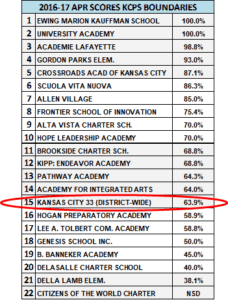If we can separate the key premise of charter schools – autonomy for accountability – from the negative politics that surround them, could we get farther in improving all of our schools?
The Kansas City Star editorial board recently wrote, in response to KCPS falling short of full accreditation, that “charter schools aren’t the salvation” for public education in Kansas City.

Although KC charters perform better than The Star would suggest (see chart), real changes are needed to strengthen the accountability environment for Missouri charter schools. In the absence of these changes, The Star is probably right: charters on their own won’t be our salvation.
Then again, I’m wary of ever relying on a single solution to solve really hard problems.
But the paper’s vague calls for “heightened efforts from educators” and more community involvement in support of KCPS, while important and well-intentioned, aren’t likely to get us very far either.
It’s our responsibility as adults to create successful learning environments in schools.
And when that learning environment isn’t working – when student proficiency is continuously low, when we have schools that we’re unable to staff properly, or even recruit substitute teachers for – we have a responsibility to change that environment.
But to hold schools accountable in this way, you must first give them real power over staffing, curriculum, and budget. These are the biggest levers a school leader has to change the overall trajectory of a school.
When implemented with fidelity and rigor, we know this charter school model for organizing and operating schools works (see the research here).
Accountability is mentioned eight times in the KCPS 2018-2023 strategic plan. But it’s this word –autonomy – that’s altogether missing.
Is there a way to do “autonomy for accountability” better?
So I’ve been wondering recently: Can we take this core idea of “autonomy for accountability” that charter schools represent, and do it better?
Because if you can separate the idea of charters from the negative politics that surround them, there’s so much about the model that makes sense – and that most of us, I think, would actually agree on:
- That school leaders should be able to make staffing, curriculum and budget decisions in the best interest of their students and school communities.
- That there should be fewer layers of bureaucracy – less distance – between parents and school staff.
- That schools should be evaluated regularly and held accountable for their academic performance. Failing schools shouldn’t be allowed to fail students year after year.
Is there a way that we harness these powerful ideas on behalf of KCPS and its students, rather than at the district’s expense?
The short answer: Yes!
I’ll explore this idea in more depth in my next post.
_________________
A note on APR scores: APR scores are a bundled score of individual metrics that our state department of education uses to evaluate school performance on an annual basis.
DESE just released 2017 district-level scores for the state of Missouri last week. Scores are based on academic achievement, sub-group achievement, college and career readiness, attendance, and graduation rates. Here’s a good article from the News Tribune in Columbia, MO from January 2017 that explains in more depth what the APR is: “What is the Annual Performance Report?”
If you’re interested in the raw data that breaks down scores based on individual metrics, you can find these data for the last four years on the DESE website: click here and then on “Missouri 2017 APR Summary by districts”.